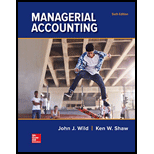
Concept introduction:
Present Value:
Present value of money means the present or current value of a future
Future Value:
The future value is the value of present cash flow at specified time period and at specified
Requirement 1:
We have to determine the interest rate column and number of period row while estimating future value.
Answer to Problem 1QS
The interest rate column we will refer is 12% and year row will be of 2 years.
Explanation of Solution
Since the rate of interest is 12% annually and time period is 2 years. Therefore the interest rate column will be of 12% and time period row will be of 2 years.
Concept introduction:
Present Value:
Present value of money means the present or current value of a future cash flow at a given rate of interest or return.
Future Value:
The future value is the value of present cash flow at specified time period and at specified rate of return.
Requirement 2:
We have to determine the interest rate column and number of period row while estimating future value.
Answer to Problem 1QS
The interest rate column we will refer is 3% and year row will be of 4 years.
Explanation of Solution
Since the rate of interest is 6% annual rate, compounded semi annually and time period is 2 years. Therefore the interest rate column will be of 3% (6%/2) and time period row will be of 4(2*2) years.
Concept introduction:
Present Value:
Present value of money means the present or current value of a future cash flow at a given rate of interest or return.
Future Value:
The future value is the value of present cash flow at specified time period and at specified rate of return.
Requirement 3:
We have to determine the interest rate column and number of period row while estimating future value.
Answer to Problem 1QS
The interest rate column we will refer is 2% and year row will be of 8 years.
Explanation of Solution
Since the rate of interest is 8% annual rate, compounded quarterly and time period is 2 years. Therefore the interest rate column will be of 2% (8%/4) and time period row will be of 8(2*4) years.
Concept introduction:
Present Value:
Present value of money means the present or current value of a future cash flow at a given rate of interest or return.
Future Value:
The future value is the value of present cash flow at specified time period and at specified rate of return.
Requirement 4:
We have to determine the interest rate column and number of period row while estimating future value.
Answer to Problem 1QS
The interest rate column we will refer is 1% and year row is not shown in table B.2
Explanation of Solution
Since the rate of interest is 12% annual rate, compounded monthly and time period is 2 years. Therefore the interest rate column will be of 1% (12%/12) and time period row will be of 24(2*12) years but it is not shown in table B.2
Want to see more full solutions like this?
- On January 1, 2019, Edvard Corporation acquired a manufacturing machine at a cost of $960,000. It is to be depreciated on the straight-line method over a 6-year period with no residual value. Due to a bookkeeping error, no depreciation was recognized in Edvard's 2019 financial statements. The oversight was discovered during the preparation of Edvard's 2020 financial statements. Depreciation expense on this machine for 2020 should be____. Helparrow_forwardI need guidance with this general accounting problem using the right accounting principles.arrow_forwardWhich of the following is NOT a component of internal control? a) Control activities b) Risk assessment c) External audit d) Monitoring activities MCQarrow_forward
 College Accounting, Chapters 1-27AccountingISBN:9781337794756Author:HEINTZ, James A.Publisher:Cengage Learning,
College Accounting, Chapters 1-27AccountingISBN:9781337794756Author:HEINTZ, James A.Publisher:Cengage Learning, Financial Accounting: The Impact on Decision Make...AccountingISBN:9781305654174Author:Gary A. Porter, Curtis L. NortonPublisher:Cengage Learning
Financial Accounting: The Impact on Decision Make...AccountingISBN:9781305654174Author:Gary A. Porter, Curtis L. NortonPublisher:Cengage Learning

